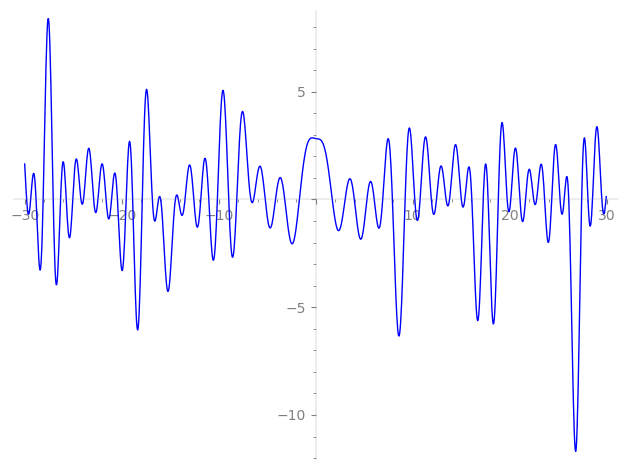| L(s) = 1 | + (1.39 + 0.228i)2-s + (1.89 + 0.638i)4-s + (0.866 − 0.5i)5-s + (−1.04 − 0.604i)7-s + (2.49 + 1.32i)8-s + (1.32 − 0.499i)10-s + (1.52 − 2.63i)11-s + (2.53 + 4.39i)13-s + (−1.32 − 1.08i)14-s + (3.18 + 2.42i)16-s − 2.23i·17-s + 2.53i·19-s + (1.96 − 0.394i)20-s + (2.72 − 3.32i)22-s + (−3.48 − 6.02i)23-s + ⋯ |
| L(s) = 1 | + (0.986 + 0.161i)2-s + (0.947 + 0.319i)4-s + (0.387 − 0.223i)5-s + (−0.395 − 0.228i)7-s + (0.883 + 0.468i)8-s + (0.418 − 0.157i)10-s + (0.458 − 0.794i)11-s + (0.704 + 1.21i)13-s + (−0.353 − 0.289i)14-s + (0.795 + 0.605i)16-s − 0.543i·17-s + 0.582i·19-s + (0.438 − 0.0881i)20-s + (0.581 − 0.709i)22-s + (−0.725 − 1.25i)23-s + ⋯ |
\[\begin{aligned}\Lambda(s)=\mathstrut & 540 ^{s/2} \, \Gamma_{\C}(s) \, L(s)\cr =\mathstrut & (0.987 - 0.159i)\, \overline{\Lambda}(2-s) \end{aligned}\]
\[\begin{aligned}\Lambda(s)=\mathstrut & 540 ^{s/2} \, \Gamma_{\C}(s+1/2) \, L(s)\cr =\mathstrut & (0.987 - 0.159i)\, \overline{\Lambda}(1-s) \end{aligned}\]
Particular Values
| \(L(1)\) |
\(\approx\) |
\(2.81908 + 0.226410i\) |
| \(L(\frac12)\) |
\(\approx\) |
\(2.81908 + 0.226410i\) |
| \(L(\frac{3}{2})\) |
|
not available |
| \(L(1)\) |
|
not available |
\(L(s) = \displaystyle \prod_{p} F_p(p^{-s})^{-1} \)
| $p$ | $F_p(T)$ |
|---|
| bad | 2 | \( 1 + (-1.39 - 0.228i)T \) |
| 3 | \( 1 \) |
| 5 | \( 1 + (-0.866 + 0.5i)T \) |
| good | 7 | \( 1 + (1.04 + 0.604i)T + (3.5 + 6.06i)T^{2} \) |
| 11 | \( 1 + (-1.52 + 2.63i)T + (-5.5 - 9.52i)T^{2} \) |
| 13 | \( 1 + (-2.53 - 4.39i)T + (-6.5 + 11.2i)T^{2} \) |
| 17 | \( 1 + 2.23iT - 17T^{2} \) |
| 19 | \( 1 - 2.53iT - 19T^{2} \) |
| 23 | \( 1 + (3.48 + 6.02i)T + (-11.5 + 19.9i)T^{2} \) |
| 29 | \( 1 + (-4.84 - 2.79i)T + (14.5 + 25.1i)T^{2} \) |
| 31 | \( 1 + (2.83 - 1.63i)T + (15.5 - 26.8i)T^{2} \) |
| 37 | \( 1 + 10.3T + 37T^{2} \) |
| 41 | \( 1 + (3.70 - 2.13i)T + (20.5 - 35.5i)T^{2} \) |
| 43 | \( 1 + (-3.74 - 2.15i)T + (21.5 + 37.2i)T^{2} \) |
| 47 | \( 1 + (5.15 - 8.92i)T + (-23.5 - 40.7i)T^{2} \) |
| 53 | \( 1 + 9.42iT - 53T^{2} \) |
| 59 | \( 1 + (4.46 + 7.73i)T + (-29.5 + 51.0i)T^{2} \) |
| 61 | \( 1 + (-1.32 + 2.30i)T + (-30.5 - 52.8i)T^{2} \) |
| 67 | \( 1 + (12.4 - 7.20i)T + (33.5 - 58.0i)T^{2} \) |
| 71 | \( 1 - 3.49T + 71T^{2} \) |
| 73 | \( 1 - 5.10T + 73T^{2} \) |
| 79 | \( 1 + (-3.26 - 1.88i)T + (39.5 + 68.4i)T^{2} \) |
| 83 | \( 1 + (0.286 - 0.495i)T + (-41.5 - 71.8i)T^{2} \) |
| 89 | \( 1 + 2.40iT - 89T^{2} \) |
| 97 | \( 1 + (-5.82 + 10.0i)T + (-48.5 - 84.0i)T^{2} \) |
| show more | |
| show less | |
\(L(s) = \displaystyle\prod_p \ \prod_{j=1}^{2} (1 - \alpha_{j,p}\, p^{-s})^{-1}\)
Imaginary part of the first few zeros on the critical line
−11.02134759852004813818547695811, −10.13904082332617053845340681396, −8.972293102282007333586938041305, −8.141953009966862339323172416379, −6.68207890001558464486737108499, −6.40512918814453897930996808465, −5.20468454980249245363370821221, −4.14611497746566808543584531548, −3.19284411197862697543790302530, −1.68331929007880971824943886323,
1.70326088207121485607913461368, 3.02858880103276919913539173701, 3.97982873305563307372644328570, 5.27760922193629525041747002753, 6.03269729087591338965438613437, 6.90446560800969431561565556685, 7.905451397370390924021903977107, 9.213831414712777426454009561094, 10.21035229272497599156118492539, 10.75743229626809900200632174674

